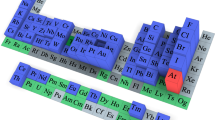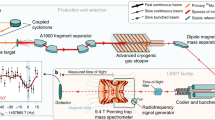Abstract
EXPERIMENTAL and theoretical work has shown the existence of remarkably narrow resonance levels for the absorption of slow neutrons in certain nuclei1–5. In the cases of rhodium, silver (group A) and gold, the natural half-value width can be estimated as 0·06 volt, 0·05 volt and 0·12 volt, respectively. These values, however, may include errors of the order of 100 per cent. It has been pointed out by Frisch5 that these widths are comparable with the Doppler width which such resonance must show in consequence of the thermal agitation of the capturing nuclei. According to Bethe and Placzek3, the Doppler width is Er being the resonance energy and M the mass of the nucleus. This leads to the following widths at room temperature: 0·07 volt for rhodium, 0·1 volt for silver, 0·12 volt for gold. In the case of silver, the Doppler width seems to be even greater than the natural width. In this case, heating a silver absorber should influence considerably the absorption in the middle of the resonance line. In consequence of the Doppler broadening, the absorption in the middle of the line should decrease with increasing temperature of the absorber. Therefore this effect should be observed with a thin detector, which is sensitive principally to the middle of the line.
This is a preview of subscription content, access via your institution
Access options
Subscribe to this journal
Receive 51 print issues and online access
$199.00 per year
only $3.90 per issue
Buy this article
- Purchase on Springer Link
- Instant access to full article PDF
Prices may be subject to local taxes which are calculated during checkout
Similar content being viewed by others
References
Amaldi, E., and Fermi, E., Phys. Rev., 50, 899 (1936).
Breit and Wigner, Phys. Rev., 49, 519 (1936).
Bethe, H. A., and Placzek, G., Phys. Rev., 51, 450 (1937).
v. Halban, H., and Preiswerk, P., J. Phys., 8, 29 (1937).
Frisch, O. R., Kgl. Danske Vid. Selsk., 14, 12 (1937).
Author information
Authors and Affiliations
Rights and permissions
About this article
Cite this article
VON HALBAN, H., PAXTON, H. Doppler Effect of Nuclear Resonance Level. Nature 141, 116 (1938). https://doi.org/10.1038/141116a0
Published:
Issue Date:
DOI: https://doi.org/10.1038/141116a0
This article is cited by
-
Absorption of Group A Neutrons in Silver
Nature (1938)
-
Capture Cross-sections for 220 Kev. Neutrons
Nature (1938)
Comments
By submitting a comment you agree to abide by our Terms and Community Guidelines. If you find something abusive or that does not comply with our terms or guidelines please flag it as inappropriate.



